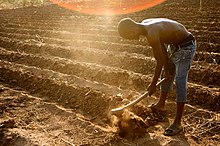Village community (ethnology)
As a village community , anthropology and ethnology designate a social group of several hundred traditional soil farmers who live as a community of convenience (at least for many years) in a certain place ( village ). In contrast to moving field farmers and nomads , the relationships between people no longer play the decisive role. The social relationships are of a neighborly nature and are strengthened by a multitude of norms (customs, traditions, festivals, etc.).
A distinction is made between autonomous and dependent village communities.
Autonomous village communities
The more the supply of a village is secured through subsistence farming , the more the community is economically self-sufficient and politically autonomous. This was the case before the formation of modern states in agriculture. This still applies to a greater or lesser extent to communities that practice semi-intensive hoeing and land swapping and only participate marginally in regional markets .
Although many subsistence-oriented communities have solid livelihoods, from a Eurocentric perspective , their way of life is usually equated with poverty and underdevelopment.
Dependent village communities in peasant cultures
Village communities as food-producing units of states, which ethnology describes as pre-industrial “peasant cultures” , are economically dependent on market events and politically dependent on the arbitrariness of those in power. By means of intensive, traditional agriculture (ie with the help of technical equipment, fertilization and permanent use of the fields) they generate a surplus that ensures the supply of parts of the population outside their own village. Small family businesses are the basis of such dependent village communities.
Indigenous communities , located in the assimilation process are (see also: cultural change ) , often combine the traditional self-catering with integration in an organized market or cash economy . They are referred to as " peasant societies ".
The dependency of the rural village communities has always been characterized by oppression, exploitation and labor .
See also
Individual evidence
- ↑ Klaus E. Müller: Shamanism. Healers, spirits, rituals. 4th edition, CH Beck, Munich 2010 (original edition 1997), ISBN 978-3-406-41872-3 . P. 24.
- ↑ Veronika Bennholdt-Thomsen: Subsistence economy, global economy, regional economy. In: Maren A. Jochimsen, Ulrike Knobloch (Hrsg.): Lifeworld economy in times of economic globalization. Kleine, Bielefeld 2006, pp. 65–88
- ^ World Bank : World Bank annual report 1975 (English). USA 1975, p. 20 ( online at worldbank.org).
- ↑ a b Klaus E. Müller: Shamanism. Healers, spirits, rituals. 4th edition, CH Beck, Munich 2010 (original edition 1997), ISBN 978-3-406-41872-3 . P. 27.
- ^ Walter Hirschberg (founder), Wolfgang Müller (editor): Dictionary of Ethnology. New edition, 2nd edition, Reimer, Berlin 2005. pp. 42–43.


